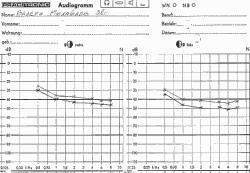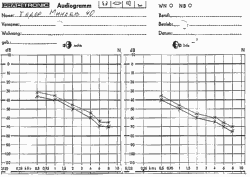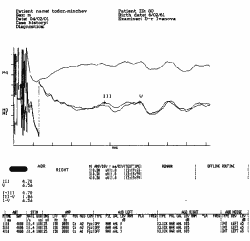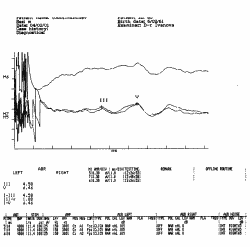

|
Journal Home Contents Preview Next |
Pro Otology
Balkan Journal of Otology & Neuro-Otology, Vol. 2, No 1:26-29 © 2002
All rights reserved. Published by Pro Otology Association
Auditory Evoked Brainstem Responses (ABR) of Patients
with Hearing Loss, Suffering from Chronic Alcoholism
Zlatina Zhelyazkova, Rumen Benchev
Department of Otorhinolaryngology, Medical Institute of Ministry of Interior, Sofia, Bulgaria
ABSTRACT
Objective: The purpose of this study was to clarify the necessity of complete audiological examination of patients, suffering from chronic alcoholism in order to be precise in diagnostic of their hearing loss and respectively to be exact in the treatment of their disorders.
Study Design: The study design was a retrospective review.
Setting: This study was performed at the Department of Otorhinolaryngology, the Department of Neurology and the Department of Gastroenterology in the Medical Institute - Ministry of Interior, Sofia.
Patients: The study included 80 patients with hearing loss, suffering from chronic alcoholism.
Intervention: The patients received systemic therapy for their neurological or gastroenterological problems, as well as adequate therapy for their hearing loss.
Main Outcome Measures: The patients passed precise otorhinolaryngological and neurotological examination including pure tone audiometry and auditory brainstem responses.
Results: The examined 80 patients, suffering from chronic alcoholism had hearing loss of sensorineural type. 34 patients /43%/ showed prolonged latency of I-V wave and prolonged interspike intervals. 46 patients /57%/ showed weak prolongation of the I wave and normal appearance of ABR.
Conclusions: The results of the complex examinations lead us to the conclusion of the engagement of the peripheral structures of the auditory system and the central auditory pathways by the toxic agent - alcohol, causing hearing loss. Almost half of the patients being with sensorineural hearing loss showed abnormality of the ABR which indicates involvement of the auditory pathways and further complex and adequate treatment.
Key words: Chronic alcoholism, Hearing loss, Auditory evoked response audiometry.
Pro Otology 1: 26-29, 2002
INTRODUCTION
The Auditory-Evoked Brainstem Response is a noninvasive objective auditory method used to evaluate the integrity of the auditory pathways. It is one of the best and most popular clinical measure used for the identification of cochlear and retrocochlear disorders and for threshold testing. The auditory evoked brainstem response is a powerful test because it does not require the cooperation of the patient. The advantage is that the surface electrodes are used and anesthesia is not required. Calibrated clicks are delivered to one ear, and electrical events are recorded from an electrode place on the scalp. The method is applied to the auditory system where a repetitive stereotyped neural response is elicited thousand of time. A high-speed computer digitizes and averages multiple recordings in real time, extracting the neural signal in process. Typically some 1000 to 2000 responses are averaged, resulting in record of a complex waveform known as brainstem auditory evoked response. Within the first 10 msec of the presentation of the click, five negative peaks are identified in the ABR recording. The electrical events that contribute to these peaks originate in the brainstem auditory structures. Be noting the delay or absence of the peaks, one can quite accurately locates brainstem lesions. The ABR is characterized by a series of waves that appear at standardized latencies following the presentation of a click stimulus. Seven waves (I-VII) correspond to auditory nerve, cochlear nuclei, superior olivary nucleus, lateral lemniscus, inferior colliculus, medial geniculate body and auditory radiations (1,4,5). So this objective method gives us information of the function and abnormalities through the entire auditory pathway from cochlea to cortex.
PATIENTS AND METHODS
The study included 80 patients, using 10-15 years alcohol, being in the way of chronic intoxication. Some of the subjects from the Department of Neurology had pollyneuropathy, others from the Department of Gastroenterology had chronic hepatitis. All the patients were with the characteristic symtomps of chronic alcohol intoxication:
-alcohol abuse;
-absence of quantitative control so that immediately after the beginning of the consumption of alcohol the patient reaches intoxication;
- increased tolerance to alcohol;
- chronic and progradient performance of the disease during the systematic consumption;
- absence of the remembrance of the life action during the drinking;
- psychogenic impairments and social inadequate behavior.
All the patients overwent the complete otorhinolaryngological examination and the standard neurootological examination. Pure tone audiometry and auditory evoked brainstem response were performed. We used as a stimulus for ABR audiometry wide-band click of 90 dB. A series of seven waves were recorded from the vertex-mastoid electrode derivation during the first 10-15 msec following moderately intense stimulation with the click. The following variables were analyzed:
- presence or absence of the various waves;
- waveform morphology;
- quantitative measures of peak latencies;
- interpeak intervals;
- interpeak latency differences;
- wave V - latency.

|

|
|
|
FIG. 1. Audiogram of flat type hedring loss. |
FIG. 2. Audiogram of slopping type hearing loss. |
RESULTS
All the examined patients had hearing loss for high frequencies. Pure tone audiometry showed two types of audiograms:
a) I -st group - 46 patients - audiogram of flat hearing impairment (Fig. 1)
b) II-nd group - 34 patients - slopping audiogram of sensorineural hearing loss (with loss greater in the higher frequencies)(Fig. 2).
We used in our examination a click of intensity of 90dB as a stimulus of the auditory response. The ABR occurs approximately between 10 and 15 msec after stimulus onset. The fifth wave as usual (2,3) was the largest one, but there were differences of the latencies and interpeak intervals.
The patients with pancochlear hearing loss - with audiogram of flat type showed presence of all the waves, which were of normal morphology of the Auditory-evoked Brainstem Response. These patients exhibit responses at normal absolute latencies and interpeak intervals (Fig. 3).
The second group patients with sensorineural hearing loss with sloping audiogram had hearing loss more than 50dB at 4000, 6000 and 8000Hz. Their Auditory-evoked Brainstem Response showed prolongation between I -st and III-rd waves and prolongation of the latency of the V-th wave ( Fig. 4a,b).
The obtained results showed that 57% of the examined patients had cochlear earing impairment and almost normal auditory-evoked brainstem responses. 43% had abnormality of the transmission of the nervous impulse through the auditory pathways up to the lemniscus lateralis, where the fifth wave is generated and to the collicullus inferior. The patients with higher hearing thresholds that are with severe impairment of the cochlea, showed prolongation of the transmission of the nervous impulse.

|

|
|
|
FIG. 4a. ABR of right ear of patient with audiogram of sloping type. |
FIG. 4b. ABR of left ear of patient with audiogram of sloping type. |
DISCUSSION
Being a toxic agent, the alcohol acts upon a lot of neurological structures, including the auditory system. We have observed a great amount of patients, suffering from chronic alcoholism with sensorineural hearing loss and different vestibular disorders.The high-frequency hearing loss due to selective removal of basal units by the toxic agent - the alcohol, tends to bias the broad-band click-evoked action potential and ABR toward more apical units. Therefore, high-frequency cochlear deficits prolong peak latencies and low-frequency deficit does not cause a corresponding basalward shift, because of the already existing heavy bias toward basal units in the normal response. Therefore, low-frequency cochlear deficits have no apparent effect on action potential and auditory-evoked brainstem response latencies. The auditory-nerve action potential is the sum of the waveforms of single-fiber auditory-nerve spikes. The single-unit spikes are triggered by the passage of the cochlear travelling wave. Thus, spikes from basal (high frequency) fibers appear at the recording electrode earlier than spikes from apical (low-frequency) fibers. High frequency (basal) fibers contribute more effectively to the whole nerve action potential and also to the ABR than to low-frequency fibers, because the degree to which the single neural-unit responses contribute to the evoked potential is determined largely by their synchrony. Our study shows, that sensory hearing loss at 4000, 6000 and 8000 Hz above 50dB and upper correspond to gradual increase of the time of the response of the action potential, which is projected by the prolonged latency. That means, that where there is such sensorineural hearing loss, the auditory pathways are also involved in the impairment. When the hearing loss is equal at 1000, 2000,4000,6000 and 8000 Hz and is about 40-50dB, there are no significant changes from the normal ABR and respectively the disorders are only at cochlear level.
CONCLUSIONS
The results of our examination of the patients, suffering from chronic alcoholism show the impairment of the auditory system, caused by the toxic agent. Both the pancochlear and the sensorineural hearing loss gradually increasing at high frequencies and involving auditory pathways need treatment.
REFERENCES
Biacabe B, Chevallier JM, Avan P, Bonfils P. Functional anatomy of auditory brainstem nuclei: application to the anatomical basis of brainstem auditory evoked potentials. Auris Nasus Larynx 2000;28(1):85-94.
Glautier S, Spencer K. Activation of alcohol-related associative networks by recent alcohol consumption and alcohol-related cues. Addiction 1999;94(7):1033-41.
Mario A. Ruggero, Nola C. Rich, Bhagyalakshmi G. Shivapuja, Andrei N. Temchin. Auditory-Nerve Responses to Low-frequency Tones: Intensity Dependence. Auditory Neuroscience 1995;2(2).
Nong DX, Ura M, Owa T, Noda Y. An acoustically evoked short latency negative response in profound hearing loss patients. Acta Otolaryngol 2000;120(8):960-6.
Popescu M, Papadimitriou S, Karamitsos D, Bezerianos A. Adaptive denoising and multiscale detection of the v wave in brainstem auditory evoked potentials. Audiol Neurootol 1999;4(1):38-50.
|
Pro Otology |
Journal Home Contents Preview Next |